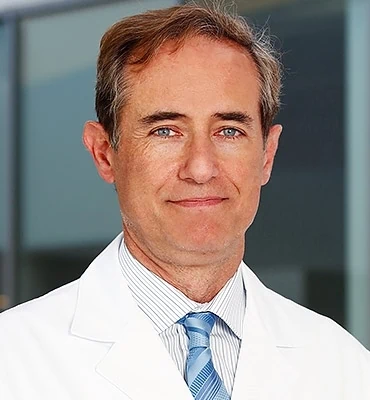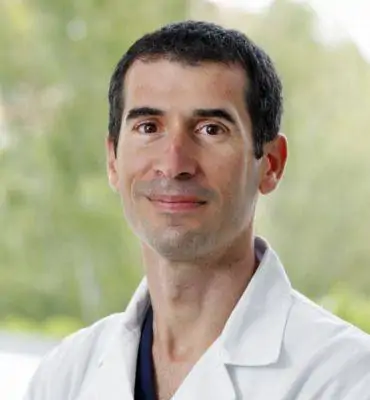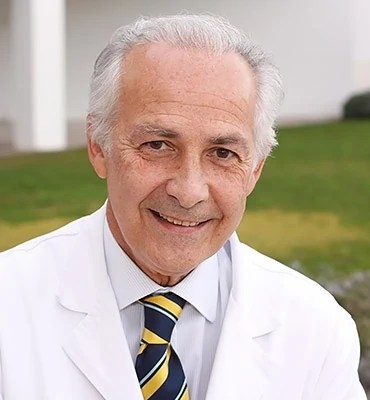What does it involve?
Scleral buckling is a surgery that involves fitting silicone elements over the sclera. These elements are sutured to the wall of the sclera, where retinal tears usually occur.
It is also necessary to combine the fitting of silicone elements with cryocoagulation or laser coagulation to repair the retinal tears.
When is it carried out?
It is performed in retinal detachment cases occurring for the first time, enabling repair without the need to work within the eye.
Prior examination
A comprehensive eye examination is required, including a thorough examination of the detached area to identify all of the tears. The examination is performed with a binocular indirect ophthalmoscope and a three-mirror lens through a slit lamp.
Before the surgery
Those associated with all surgery.
Surgery
The ocular muscles have to be dissected and held by threads, and the eye moved to suture the silicone piece. It is usually performed with retrobulbar anaesthesia and sedation, i.e. local anaesthesia and patient sedation.
Risks
The main risk is that the retinal detachment will not be corrected by this technique, if all of the tears have not been correctly identified. It can also cause bleeding and inflammation, but these complications occur in exceptional cases.
Associated pathologies
Experts performing this treatment
FAQs
Eye tumours can occur on any tissue, but the most common in adults is choroidal melanoma, a malignant tumour that can be treated with radiotherapy and other treatments with notable success. Malignant tumours can also appear on the conjunctiva, the lacrimal gland and the orbit. Benign tumours can also appear, but they can be easily dried out. In children a retinal tumour known as retinoblastoma can appear, which looks like a white pupil and must be treated as soon as possible, as it can be life-threatening if appropriate treatment is not performed.
The symptoms of a detached retina are the presence of flashes of light (photopsia) or objects floating in the vitreous humour and, occasionally, a progressive shadow and loss of vision. It is important to contact your ophthalmologist as quickly as possible. It is not an emergency, but it needs to be operated on as soon as possible by a surgeon.
If there is no gas or silicone oil, the patient can sleep in any position. If there is no covering element (gas or silicone oil), the patient’s position is unimportant.
IMO Institute of Ocular Microsurgery
Josep María Lladó, 3
08035 Barcelona
Phone: (+34) 934 000 700
E-mail: international@imo.es
See map on Google Maps
By car
GPS navigator coordinates:
41º 24’ 38” N – 02º 07’ 29” E
Exit 7 of the Ronda de Dalt (mountain side). The clinic has a car park with more than 200 parking spaces.
By bus
Autobus H2: Rotonda de Bellesguard, parada 1540
Autobus 196: Josep Maria Lladó-Bellesguard, parada 3191
Autobuses H2, 123, 196: Ronda de Dalt – Bellesguard, parada 0071
How to arrive at IMO from:
IMO Madrid
C/ Valle de Pinares Llanos, 3
28035 Madrid
Phone: (+34) 910 783 783
See map in Google Maps
Public transport
Metro Lacoma (líne 7)
Autobuses:
- Lines 49 & 64, stop “Senda del Infante”
- Line N21, stop “Metro Lacoma”
Timetables
Patient care:
Monday to Friday, 8 a.m. to 9 p.m.
IMO Andorra
Av. de les Nacions Unides, 17
AD700 Escaldes-Engordany, Andorra
Phone: (+376) 688 55 44
See map in Google Maps
IMO Manresa
C/ Carrasco i Formiguera, 33 (Baixos)
08242 – Manresa
Tel: (+34) 938 749 160
See map in Google Maps
Public transport
FGC. Line R5 & R50 direction Manresa. Station/Stop: Baixador de Manresa
Timetables
Monday to Friday, 09:00 A.M – 07:00 PM








